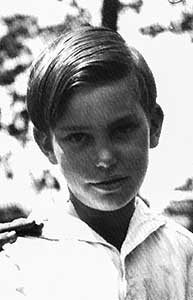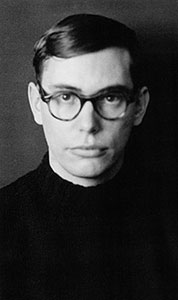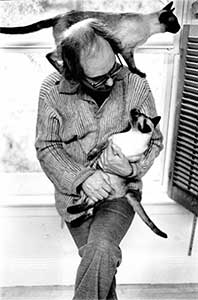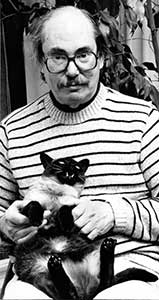
Artist
Eugene Larkin was born into a farming family of seven children in rural Minnesota in 1921.

The landscape and rhythms of agricultural life were a strong early influence, as was the artistic example of his painter mother, Martha.
Larkin attended the University of Minnesota, graduating with an M.A. in 1947. As a student of the art historian Lawrence Schmeckebier, an authority on the art of the Mexican muralists, he was soon introduced to the expressionism and political engagement of German and Mexican artists of the 1920s and 30s. An early cycle of prints and drawings on the life of labor activist Joe Hill, with a catalog introduction by the novelist and activist Meridel LeSeur, reflected the artist's deep identification with the political struggles of the early labor union movement. The gestural expressionism that animated these early works remained characteristic throughout his career.

Larkin's attention was soon captured by other themes: the drama of live chamber music and the elemental landscape of the northern Great Lakes. Larkin's wife, Audrey, was an amateur violinist, and their friendship with composer Markwood Holmes led to Larkin's work on the libretto of Holmes' opera Telemachus. In the years that followed, the couple formed many friendships with members of the Minneapolis Symphony, and string quartet rehearsals took place regularly in the Larkin household and were “recorded” by Eugene in a series of powerful brush drawings. Calligraphic forms of viola, violin and cello became ink drawings on paper, then translated into large multicolored woodcuts. During the summer months, on breaks from teaching at the Minneapolis Institute of Arts, Eugene and his family made trips to the north shore of Lake Superior, where the woodcut methods that he had used in his images of chamber music were employed in describing the pines, waves and ancient basalt flows of the spectacular Grand Marais shoreline. Working at a small portable easel with oriental brushes and colored washes, the gestures of crashing waves were transcribed with gestures of watercolor, and back in his Minneapolis studio, transformed into gestural carvings on woodcut blocks.
In the early 1960s, Larkin was awarded a Ford Foundation grant to study at the newly formed Tamarind Institute, where he was introduced to the technique of stone lithography by the master printer Garo Antresian. Brush drawing once again played a role, and inky drawings on transfer paper were printed from litho stones, extending the tonal range of his work. During this period, however, Larkin began experimenting with a new technical direction that would come to dominate his creative output for several decades. Tree and plant forms had always been a favorite theme, and the artist realized that he could make a printed “rubbing” of an actual plant by covering a plant with paper, placing an uncarved inked woodblock on top and passing them together through his printing press. The process yielded tonally complex printed material that could be cut and reassembled into abstract collages; and the woodblocks, embossed by the plant forms during the process, could be reprinted to produce additional raw material. The accidental spatial and compositional arrangements of these cut up and collaged materials transmuted simple vegetative forms into arrangements richly imbued with figurative associations. Further, the same process could be carried out on lithographic transfer paper, yielding a print rather than a collage as a finished result.

An abiding reverence for the history of Western art and its poetic and mythological heritage had from the beginning been a vital element in the artist's thought process. During this period, mythology served as a point of departure for the formal improvisations of his collages. Print series from the 1960s and 70s based on Egyptian and Greek mythology were the direct outcome of the artist's involvement with these themes and techniques, a trend given further impetus by a prolonged tour of Europe conducted during a sabbatical leave in 1966. The artist did not abandon his earlier involvement with woodcut however; he resumed his work with a string quartet, and the images that emerged from these sessions show the figures of the performers abstracted into dramatic networks of single powerful brushstrokes, recalling works of the abstract expressionist Franz Klein.
Larkin was now appointed to a professorship at the University of Minnesota, where he taught art history and design. He had collaborated previously with several skilled printers, among them Kenji Akagawa and Jerry Martin, but around this time that role began to be filled by his son Alan Larkin, himself a printmaker and art professor at Indiana University in South Bend. Alan and Eugene worked together from then on to create editions of Eugene's printed work. Production of collages continued apace, many of them large scale works with printed papers adhered to canvas. Using an experimental paper manufactured by 3M, Larkin had begun, in Alan's words, to “draw with scissors”, exploring accidental relationships of printed rubbings, woodcut fragments and solid fields of color, flowing collaged abstractions with architectural, totemic and even erotic overtones.

Larkin's work as an instructor of two and three-dimensional design came to influence his vision in a number of new ways, as he introduced his students to problems in design and composition. As a teacher, he often based assignments on art historical examples that illustrated the visual issues he discussed in class; not surprisingly, he would often explore these same issues in his own work. A consideration of line quality in the plant drawings of Ellsworth Kelly led to a series of woodcuts of germinating plant forms, one of which was presented by Vice President Walter Mondale to Soviet Premier Alexei Kosygin. His organization of a symposium on the work of English designer William Morris at the University of Minnesota led to a series of collages based on Morris' novel News from Nowhere. His instructional work in 3D design led to the installation within his department of an innovative “space lab”, which allowed his students to build room-sized 3D modular compositions. Eventually, the artist summarized his thoughts on composition and design in a widely adopted design text, Design, The Search for Unity, published in 1988.
Eugene Larkin exhibited extensively throughout his career, with over 120 exhibitions within the United States and abroad. A winner of numerous awards, his works are in the collections of the Frederick R. Weisman Art Museum at the University of Minnesota, the Minneapolis Institute of Arts, the Walker Art Center, the Museum of Modern Art (New York), The Library of Congress, the National Gallery of Art (Washington D.C.) and the Art Institute of Chicago. A final retrospective exhibition of his work was held at the Frederick Weisman gallery in 2009, the year before his death.